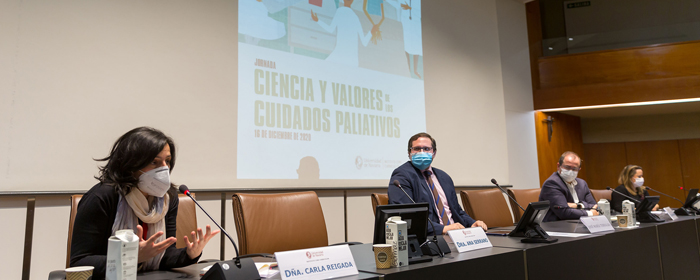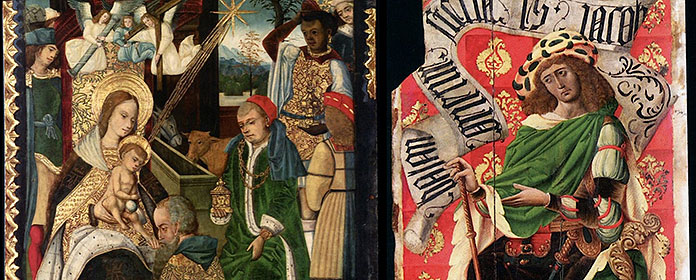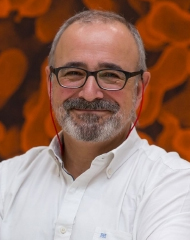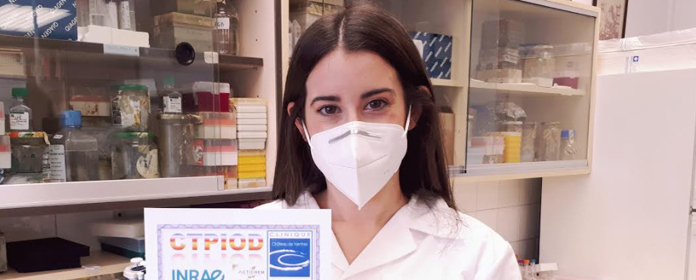The Museum closes the lecture series "El Museo Del Prado: Hitos Históricos de sus colecciones" with a total of 1,750 attendees.
The lecture series was held for the first time at the Museo Universidad de Navarra and ended with the lecture of Luis Fernández-Galiano, Full Professor of projects of the Escuela Técnica Superior de Arquitectura de Madrid.
The Museum closed the lecture series "El Museo del Prado: Hitos históricos de sus colecciones" with a balance of more than 1,750 attendees, that is, 250 participants per lecture. The course, organized by the Fundación Amigos del Museo del Prado and the School of Philosophy y Letras was supported by sponsorship of Viscofán and partnership of the Fundación Diario de Navarra.
The Friends of the Prado Museum Foundation was interested in the University Museum of Navarra to organize this year's lecture series in the region. "With the Museo Universidad de Navarra we share the illusion of spreading the work of the artists," explained Nuria de Miguel, administrative assistant of the Friends of the Prado Museum Foundation. The President of board of trustees of Promoters of the Museo Universidad de Navarra, Ángel Gómez-Montoro, explained that the Museum "joins with the Museo del Prado to disseminate the art collections to society", thus becoming an art center whose collections are in dialogue with those of other first-rate museums.
The issue attendees amounted to 1,750 , including 20% university students, about 10% of university professors and teachers from schools and institutes of Navarra, 2% of participants of the Senior Program of the University of Navarra and the rest, 68% are citizens of the region.
<br>Siete conferencias con siete ponentes excepcionales<br>
Francisco Calvo Serraller, Full Professor of Art History
The Full Professor of Art History and director of lecture series, Francisco Calvo Serraller, inaugurated this course on October 19 with a speech that established a connection between the Prado Museum and its most illustrious precedent, the Royal Collection. The cycle's director focused especially on those pieces from the Museo del Prado's collection that became icons of how the triumph of force was replaced by other values of greater rational and ethical substance, for which winning through physical violence, without convincing, is intolerable. Thus, he spoke of works such as Goya's The Firing Squad of May 2nd and Picasso's Guernica. At the end of the lecture, one of the attendees asked him how to distinguish whether a piece of art is a masterpiece or not. "A masterpiece strikes you in some way, it doesn't leave you indifferent, it invites you to reflect," answered Full Professor.
During his visit visit to Pamplona, Calvo Serraller was able to visit the Museum. "Oteiza's collection sample what the artist was at that time. Furthermore, these pieces are crucial for understanding Spanish art in the second half of the 20thcentury", said Calvo Serraller.
Miguel Falomir, director attachment of Conservation and research of the Prado Museum
"The gift of works of art first arose in Italy to entertain the leaders of European powers", thus introduced his lecture Miguel Falomir, director attachment of Conservation and research of the Prado Museum. His discussion paper established a connection between what the Prado Museum is today and what was its most illustrious precedent, the Royal Collection. He explained how most of the works that are now in the Museo del Prado did not come into the hands of monarchs or the Museo del Prado as result of an economic transaction, but as gifts or donations.
Miguel Falomir also had the opportunity to visit the Museum of the University of Navarra. "I am pleased that finally in Spain there is a real university museum that is perfectly equipped and that should be a model for the rest of Spanish universities. I was amazed by the exhibitions, the location and the academic mission statement ," said Falomir.
Rocío Sánchez Ameijeiras, Professor of Art History at the University of Santiago de Compostela.
The professor of Art History at the University of Santiago de Compostela, Rocío Sánchez Ameijeiras, gave the third session of the cycle where she explained the arrival of the Romanesque to the Prado through the frescoes of the Shrine of Our Lady of Fair Love of Vera Cruz in Maderuelo. The town, marked by a strong military character at the time due to its proximity to the border, needed to redeem itself for its faults and, therefore, "the paintings of the murals of the Shrine of Our Lady of Fair Love de la Vera Cruz had a didactic intention, they were a catechism for their time," said Sánchez Ameijeiras. These works, dating from the first half of the 12th century, were transferred to canvas and reconstructed in the Prado Museum.
Sánchez Ameijeiras' work revolves around medieval and Gothic sculpture. During her visit to the Museum she discovered that the art center has numerous works by the photographer Charles Clifford who, in the words of the professor "made many trips in the nineteenth century to photograph many of the architectural constructions in our country and that allow me to know the state of some pieces of art at that time".
Gonzalo Borrás, Full Professor emeritus of Art History at the University of Zaragoza.
"The Crucifixion by Juan de Flandes is a meditation on the death of Christ and his redemptive capacity," reflected Gonzalo Borrás in the fourth session of the series. The work, commissioned in 1509 by the Bishop of Palencia, Juan Rodríguez de Fonseca, arrived at the Prado Museum "under special circumstances since it was given as a donation by the group Ferrovial", explained Full Professor emeritus of Art History at the University of Zaragoza. The speaker was based on this work to, as he explained, "help to enjoy a work of art taking into account three elements: the commissioner, or the person who commissioned the work, the artist and the workitself".
Before his lecture, while visiting the exhibitions at the Museo Universidad de Navarra, Borrás reflected on the relationship between 20th century contemporary art and more classical art. "Art cannot be seen without taking society into account since it feeds on the ways society sees its interests... but it also feeds on the art of the past and the art of museums," he said.
Andrés Úbeda, Head of Conservation of Italian and French paintings up to 1700 at the Museo del Prado
"A success anda finding ", so highlighted, respectively, Andrés Úbeda works Blind man playing the hurdy-gurdy and St. Jerome reading a letter from George de La Tour present in the collection of the Museo del Prado. The head of Conservation of Italian and French painting until 1700 of the Prado Museum delved into the artist's finding in 1915, 300 years later, by the German Hermann Voss. After that finding, de La Tour "became the Baroque painter par excellence," said Ubeda. Therefore, the acquisition of the work Blind man playing the hurdy-gurdy in 1991 was a success for the Prado Museum and it was a finding that the work Saint Jerome reading a letter hung for years in one of the offices of the Palace of Trinidad, today home of the high school Cervantes.
"I really like the idea that the University of Navarra has hosted this magnificent collection," said Andrés Úbeda when visiting the University of Navarra Museum's exhibition "The collection of María Josefa Huarte: abstraction and modernity", "it is grade in how well resolved the presentation of the collections is the love and passion that has been put into exhibiting a collection that was also given with love to the University".
Manuela Mena, Head of Conservation of Italian and French paintings up to 1700 at the Museo del Prado
The sixth lecture of the series revolved around Goya's The Flight of Witches and The Marchioness of Santa Cruz. Manuela Mena, head of Conservation of 18th century painting and Goya, Museo del Prado, said that "Goya was interested in witches, the night, the dark. Theywere symbols of evil, ignorance and superstition". On the other hand, he also explained to the audience how the piece La Marquesa de Santa Cruz left Spain in an irregular way and ended up being auctioned at Christie's in London. Mena recalled that "it was very exciting to bring La Marquesa de Santa Cruz, by Goya, to Spain".
Luis Fernández-Galiano, Full Professor of Projects, Escuela Técnica Superior de Arquitectura de Madrid, Madrid.
The Prado Museum's collection took three centuries to develop, and its headquarters have been under construction for two. Luis Fernández-Galiano, Full Professor of Projects at the Madrid School of Architecture, closed the lecture series by explaining the transformations that the Prado Museum has undergone, most recently at the hands of Rafael Moneo, the architect who also designed the building of the University of Navarra Museum, signature . Regarding the future expansion, which includes more than 5,000 square meters of additional space, he said: "The Prado Museum has been transformed by Rafael Moneo, the architect who also designed the University of Navarra Museum.The heart of this proposal is the reconstruction of the Hall of the Kingdoms, which will serve as a new area of exhibition, but it is also important to highlight the façade, that great portico with bronze pillars, which leaves the museum open to the city."said Fernández-Galiano.



